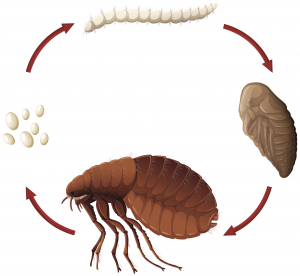
Photo Licensed by Adobe Stock Photos
As a trainer and a retail pet supply store owner, I’m often in a situation where I can help someone through a problem. There are other times, however, where I see someone doing something so terribly wrong, so injurious to a dog’s behavior, and the person can’t seem to hear me when I try and guide them towards a new way. This is ultimately stressful to me, as I can see how much potential there is to fix a problem, and yet I can also see that this dog is doomed to have the problem worsen quickly. The culprit is very often the punishment of behaviors that are fear-based. Take for example a man who came in the other day with his new dog. This little black fluffy dog had been kept in someone’s house for about 3 years, only venturing out to the back yard for potty, and now was hitting the streets for the first time. He was understandably a bit nervous, but was doing remarkably well, in my opinion. Mike and Julie had both offered him a little treat now and then while they were shopping and he was warming up quickly to both of them. I felt happy thinking that with a little encouragement he’d do pretty well after all. While the new owner was ringing up his purchases and not watching the dog, the customer behind them reached out to pet the dog, and the dog snarled and snapped at her. The owner swung around, grabbed the dog by the face, shaking him and berating him for his behavior. I swooped in and quickly suggested that we try a little something – I got down low and offered a treat to him, and his body relaxed a bit, he took it, and within moments he was approaching me and even had put his front feet up on my leg. “see that?” I said, “he’s just really inexperienced at meeting strangers – a little treat goes a long way when he’s frightened, and tells him that it’s OK to approach”. I gave the woman who had been snapped at a few treats, and had her throw one in front of him, then when he ate it, hold another out to him. Within moments the person that had been scary to him a minute ago now seemed pretty OK in his eyes. Then the owner says to her, “if I hold him still and turn him around, will you pet him?” and proceeds to restrain the dog and force him to be handled by the woman that was trying to befriend him, and he was becoming super agitated at the dog for not complying. I cut that right off, and tried so hard to point out (in the friendliest possible way) that if the dog is forced to be in a situation that he feels frightened by, then punished on top if it, that he’s going to think it’s a terrible thing to meet new people. He wasn’t asking my advice, but I sure was trying to offer it to him, as there was still time for this dog to come around. This was one of the very first places he’d ever been. I didn’t have time to explain the power of classical conditioning to help dogs through fearfulness, but I tried hard to tell him that he wasn’t being bad, he was just frightened. He managed to leave with treats in his hand, but we saw him right outside the store, jerking then grabbing, shaking, and chastising the dog as he barked at a group of people walking by. This to me is tragic. Will I see them again? If I do, will the defensive aggression he displayed have spiraled out of control, making the owner give up the dog, or just keep him at home like the last owner? Positive trainers everywhere are trying so hard to undo the damage of myths such as all bad behavior is linked to dogs needing to dominate those around them (based on a few small studies of unrelated groups of wolves in captive situations, who behave very differently in their natural social system), that you can just make a dog behave by insisting on it (whether the dog understands what is expected of him or not), and simply punishing out behaviors you don’t like, regardless of the reasons for those behaviors. This is very detrimental to dogs like the one above who just feel fear of the unknown and are trying to keep things that frighten him at a reasonable distance. If that dog felt more comfortable meeting new people, he would soon have no reason at all to bark at them and that “bad” behavior would go away. Punishing the barking/growling is like cutting the rattle off a snake – if he’s punished into suppressing those behaviors, he may be quiet but still feel incredibly uncomfortable with strangers approaching him. When someone comes along that does something he feels is terrifying, like reaching quickly for him, or grabbing his face from both sides and putting their face right up to his (“what a cute puppy! I just want to kiss you!) he might not growl or bark due to previous punishment, but may very well might reach a threshold where he feels terrified enough to defend himself and bite. How many times have you heard someone say “he bit with no warning at all!!” hmm – I’ll just bet it was a dog just like this one. He would be too frightened to growl to let you know he was reaching his threshold for what he absolutely can’t handle, because he knows growling gets him into even deeper trouble.
The dog in the photo above is a perfect example of a dog at risk of biting. She’s clearly trying hard not to lash out, but feeling extremely uncomfortable and frightened by all of the hands surrounding her. She’s displaying many textbook behaviors that say, “I’m really frightened by this”. The whites of her eyeballs are showing. She’s hunkering way down, trying to avoid the touching that frightens her so much. He ears are back, her mouth is very tense. These signs are all being missed by the kids surrounding her and whoever was taking the photo, and if she did bite, she would be blamed, even though she actually held out for some time and then perhaps felt she had no choice but to defend herself.
This is one of the very hardest things about my job.
Here’s an interesting article highlighting a survey that illustrates the correlation between using aversive, punishment based “training” is more likely to illicit additional aggressive behaviors:
http://www.sciencedaily.com/releases/2009/02/090217141540.htm
NOTE: Here’s an even better article than this blog post that I wrote later, with specific suggestions for how to help a frightened reactive dog:
To Treat Or Not To Treat? (Foundational Thinking For Creating Good Behavior In Dogs Part 2 : Choose Your Methods of Training Carefully, especially with Reactive/Fearful Dogs.
If you’re looking for a trainer, try looking for one who has an affiliation with APDT (Association of Pet Dog Trainers) or the certification “CPDT” after their names (certified pet dog trainer), whose program is based on humane training techniques.
If you’re in Portland, I’ve got a nice long list of good trainers for you. Check out this one:







 If you have pets that come in contact with your lawn, Beneficial Nematodes are an excellent weapon to use against fleas and their larvae. These Nematodes are microscopic and live below the soil surface. They like a moist environment, so our warm wet springs are a perfect time to apply them. As flea larvae emerge, they are eaten by hungry nematodes. Nematodes do not harm worms, birds, plants or the environment, in fact they are part of the environment and are found the world over
If you have pets that come in contact with your lawn, Beneficial Nematodes are an excellent weapon to use against fleas and their larvae. These Nematodes are microscopic and live below the soil surface. They like a moist environment, so our warm wet springs are a perfect time to apply them. As flea larvae emerge, they are eaten by hungry nematodes. Nematodes do not harm worms, birds, plants or the environment, in fact they are part of the environment and are found the world over
 It’s amazing how much we as a society have come to rely on stronger and stronger chemicals to get our cleaning done, and how much the simple remedies have gotten lost over time. One of the very best cleaners around is simple vinegar mixed with water. Try it on your windows or your kitchen floor. So many pets are suffering from itchy, rashy hotspot-plagued skin issues. Many people automatically assume that food is to blame (of course poor quality fats and proteins
It’s amazing how much we as a society have come to rely on stronger and stronger chemicals to get our cleaning done, and how much the simple remedies have gotten lost over time. One of the very best cleaners around is simple vinegar mixed with water. Try it on your windows or your kitchen floor. So many pets are suffering from itchy, rashy hotspot-plagued skin issues. Many people automatically assume that food is to blame (of course poor quality fats and proteins  This is excellent news for Honest Kitchen – one of our favorite pet foods. They are the only food manufacturer in the US to have proven to the FDA that every ingredient they use is suitable for human consumption – they are even made alongside other products that are for human use. They were not allowed to sell in Ohio, as the Ohio Dept of Agriculture wouldn’t allow them to print “human food grade” on the package. They took them to court and won, as the statement is true. they do not claim that the product is for humans, only that the ingredients are of such quality that it would be safe for humans to consume. It is of course formulated to meet the nutritional requirements of dogs and cats. Here’s the whole article (thanks to Itchmo for this link):
This is excellent news for Honest Kitchen – one of our favorite pet foods. They are the only food manufacturer in the US to have proven to the FDA that every ingredient they use is suitable for human consumption – they are even made alongside other products that are for human use. They were not allowed to sell in Ohio, as the Ohio Dept of Agriculture wouldn’t allow them to print “human food grade” on the package. They took them to court and won, as the statement is true. they do not claim that the product is for humans, only that the ingredients are of such quality that it would be safe for humans to consume. It is of course formulated to meet the nutritional requirements of dogs and cats. Here’s the whole article (thanks to Itchmo for this link):